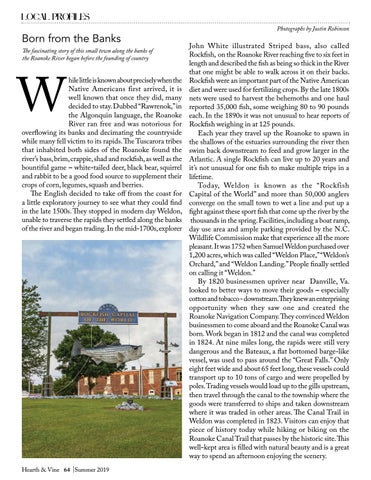LOCAL PROFILES
Born from the Banks The fascinating story of this small town along the banks of the Roanoke River began before the founding of country
hile little is known about precisely when the Native Americans first arrived, it is well known that once they did, many decided to stay. Dubbed “Rawrenok,” in the Algonquin language, the Roanoke River ran free and was notorious for overflowing its banks and decimating the countryside while many fell victim to its rapids. The Tuscarora tribes that inhabited both sides of the Roanoke found the river’s bass, brim, crappie, shad and rockfish, as well as the bountiful game – white-tailed deer, black bear, squirrel and rabbit to be a good food source to supplement their crops of corn, legumes, squash and berries. The English decided to take off from the coast for a little exploratory journey to see what they could find in the late 1500s. They stopped in modern day Weldon, unable to traverse the rapids they settled along the banks of the river and began trading. In the mid-1700s, explorer
Hearth & Vine 64 Summer 2019
Photographs by Justin Robinson
John White illustrated Striped bass, also called Rockfish, on the Roanoke River reaching five to six feet in length and described the fish as being so thick in the River that one might be able to walk across it on their backs. Rockfish were an important part of the Native American diet and were used for fertilizing crops. By the late 1800s nets were used to harvest the behemoths and one haul reported 35,000 fish, some weighing 80 to 90 pounds each. In the 1890s it was not unusual to hear reports of Rockfish weighing in at 125 pounds. Each year they travel up the Roanoke to spawn in the shallows of the estuaries surrounding the river then swim back downstream to feed and grow larger in the Atlantic. A single Rockfish can live up to 20 years and it’s not unusual for one fish to make multiple trips in a lifetime. Today, Weldon is known as the “Rockfish Capital of the World” and more than 50,000 anglers converge on the small town to wet a line and put up a fight against these sport fish that come up the river by the thousands in the spring. Facilities, including a boat ramp, day use area and ample parking provided by the N.C. Wildlife Commission make that experience all the more pleasant. It was 1752 when Samuel Weldon purchased over 1,200 acres, which was called “Weldon Place,” “Weldon’s Orchard,” and “Weldon Landing.” People finally settled on calling it “Weldon.” By 1820 businessmen upriver near Danville, Va. looked to better ways to move their goods – especially cotton and tobacco - downstream.They knew an enterprising opportunity when they saw one and created the Roanoke Navigation Company. They convinced Weldon businessmen to come aboard and the Roanoke Canal was born. Work began in 1812 and the canal was completed in 1824. At nine miles long, the rapids were still very dangerous and the Bateaux, a flat bottomed barge-like vessel, was used to pass around the “Great Falls.” Only eight feet wide and about 65 feet long, these vessels could transport up to 10 tons of cargo and were propelled by poles. Trading vessels would load up to the gills upstream, then travel through the canal to the township where the goods were transferred to ships and taken downstream where it was traded in other areas. The Canal Trail in Weldon was completed in 1823. Visitors can enjoy that piece of history today while hiking or biking on the Roanoke Canal Trail that passes by the historic site. This well-kept area is filled with natural beauty and is a great way to spend an afternoon enjoying the scenery.












